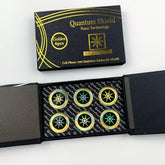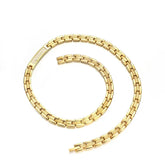What Materials Can Block EMF Radiation? A Comprehensive Guide
Electromagnetic fields (EMF) are ubiquitous in modern life, emitted by smartphones, WiFi routers, power lines, and countless other devices. With growing concerns about EMF exposure, many seek materials that can effectively block or reduce this radiation.
This article explores the science behind EMF shielding, the most effective materials, their applications, and how to evaluate their performance—all grounded in scientific principles and practical insights.
Understanding How EMF Shielding Works
What is EMF and How Does It Travel?
Electromagnetic fields (EMF) are invisible waves of energy generated by electric and magnetic fields. They span a broad electromagnetic spectrum, including:
· Radio Frequencies (RF): Emitted by WiFi, cell phones, and 5G networks (300 kHz–300 GHz).
· Extremely Low Frequencies (ELF): Produced by power lines and household appliances (3–300 Hz).
· Microwaves: Used in microwave ovens and some wireless communications (300 MHz–300 GHz).
EMF travels as oscillating waves, propagating through air, walls, and most non-conductive materials. The frequency of these waves determines their penetration ability—higher frequencies (e.g., 5G) are more easily blocked, while lower frequencies (e.g., ELF) penetrate deeper.
Shielding materials work by reflecting or absorbing these waves, preventing them from reaching the target area. For a deeper dive, read What is EMF?
What Makes a Material Effective for EMF Blocking?
The effectiveness of an EMF shielding material depends on three key properties:
1. Electrical Conductivity: Materials with high conductivity, like metals, reflect or absorb EMF, redirecting the energy.
2. Magnetic Permeability: For low-frequency ELF fields, materials with high permeability (e.g., certain steels) are needed to redirect magnetic fields.
3. Thickness and Skin Depth: The skin depth is the thickness at which EMF intensity is significantly reduced. Thicker or denser materials block more radiation.
Shielding effectiveness (SE) is measured in decibels (dB), where:
· 20 dB = 99% reduction
· 30 dB = 99.9% reduction
· 60 dB = 99.9999% reduction
Materials with high SE ratings across a range of frequencies provide the best protection. The choice of material also depends on the EMF type (RF vs. ELF) and application (e.g., home shielding vs. wearable protection).
To learn more about EMF safety, check out How to Protect Yourself from EMF Radiation?.
The Best EMF Blocking Materials (Science-Based)
Copper
Copper is one of the most effective EMF shielding materials due to its exceptional electrical conductivity. It reflects high-frequency RF signals (e.g., WiFi, 5G) and absorbs lower-frequency ELF fields. The skin effect ensures that EMF is confined to the material’s surface, preventing penetration.
Applications:
· Copper Mesh: Used in Faraday cages and window screens to block RF signals.
· Copper Foil: Applied in walls, electronics, or DIY projects for broadband shielding.
· Shielded Cables: Copper braiding in cables reduces electromagnetic interference.
Pros: High shielding effectiveness (up to 100 dB for RF), durable, widely available.
Cons: Can be expensive for large-scale projects; prone to oxidation over time.
Aluminum
Aluminum is a lightweight, cost-effective conductor that reflects RF and microwave radiation. Its broadband shielding makes it versatile for blocking signals from cell towers, WiFi, and other sources.
Applications:
· Aluminum Foil: A popular DIY solution for shielding small areas or devices.
· Aluminum Sheeting: Used in construction for EMF-proof rooms or enclosures.
· Faraday Bags: Aluminum-lined bags protect devices from external signals.
Pros: Affordable, easy to work with, effective for RF (up to 80 dB).
Cons: Less effective for ELF; thinner foils may degrade over time.
Stainless Steel
Stainless steel combines high conductivity with magnetic permeability, making it effective for both RF and ELF shielding. Its corrosion resistance ensures durability in harsh environments.
Applications:
· Steel Mesh: Used in industrial settings or home construction to block RF.
· Stainless Steel Fabric: Incorporated into EMF-protective clothing or curtains.
· Magnetic Shielding: Shields sensitive equipment from low-frequency magnetic fields.
Pros: Durable, corrosion-resistant, hybrid shielding for RF and ELF (up to 70 dB).
Cons: Heavier and more expensive than aluminum; less flexible for wearables.
Silver-Infused Fabrics
Silver is one of the most conductive metals, and when woven into textiles, it creates flexible, wearable Faraday fabrics. These materials block RF signals, including WiFi and 5G, while remaining breathable and comfortable.
For more on wearable protection, see Benefits of Wearing EMF Protection Jewelry.
Applications:
· EMF Clothing: Jackets, hats, and shirts for personal protection.
· Canopies and Curtains: Used in bedrooms to create EMF-free zones.
· Faraday Pouches: Protect phones or credit cards from hacking or tracking.
Pros: Lightweight, washable, highly effective for RF (up to 90 dB).
Cons: Expensive; silver content may degrade with frequent washing.
Carbon-Based Compounds (Graphene, Shungite)
Graphene, a single layer of carbon atoms, offers high conductivity and dielectric loss, attenuating EMF signals. Shungite, a carbon-rich mineral, contains fullerenes, which some claim enhance EMF absorption, though evidence is limited.
Applications:
· Graphene Coatings: Emerging in electronics and shielding paints.
· Shungite Tiles or Plates: Marketed for home or office use.
· Carbon Composites: Used in advanced shielding materials.
Pros: Lightweight, innovative; graphene shows promise for future applications.
Cons: Shungite’s effectiveness is debated; graphene is costly and not widely available.
Lead — Why It’s Rarely Used Despite Effectiveness
Lead’s high density and conductivity make it an excellent EMF blocker, particularly for low-frequency ELF and ionizing radiation (e.g., X-rays). It was historically used in medical and industrial shielding.
is a toxic heavy metal, posing significant health risks through skin contact or inhalation of particles. Safer alternatives like copper, aluminum, or stainless steel have largely replaced it.
Applications: Limited to specialized settings (e.g., radiology rooms).
Pros: Highly effective for ELF and ionizing radiation (up to 100 dB).
Cons: Toxic, heavy, environmentally harmful.
Learn more in Benefits of Wearing EMF Protection Jewelry.
Natural Stones & Crystals
|
Mineral |
Claims |
Scientific Evidence |
Applications |
Pros |
Cons |
|
Shungite |
Marketed as an EMF blocker and antioxidant due to fullerene content |
Minimal conductivity; <10 dB RF shielding. Antioxidant effects not related to EMF. Mostly pseudoscience |
Stones, pyramids, jewelry |
Aesthetic appeal; possible placebo effect |
Overhyped; unreliable for real EMF protection |
|
Hematite & Tourmaline |
Promoted for EMF protection and energy balancing in metaphysical circles |
Lack conductivity/permeability; no peer-reviewed evidence for EMF shielding. Benefits likely placebo-driven |
Bracelets, pendants, decorative grids |
Affordable; fashionable accessories |
No scientific support for EMF-blocking claims |
Testing EMF Blocking Effectiveness
Lab-Based Shielding dB Ratings
Certified labs use ASTM D4935 or IEEE-STD-299 standards to test shielding effectiveness. These tests measure dB reduction across a frequency range (e.g., 10 MHz–10 GHz). For example:
· Copper mesh: 60–100 dB (RF).
· Silver fabric: 50–90 dB (RF).
· Aluminum foil: 40–80 dB (RF).
Consumers should look for products with lab-verified dB ratings from reputable testing facilities to ensure performance.
Consumer-Grade EMF Meters
EMF meters allow users to measure magnetic fields, electric fields, and RF signals at home. Popular models include:
· Trifield TF2: Measures RF, magnetic, and electric fields with high sensitivity.
· Acoustimeter AM-11: Specializes in RF detection, ideal for WiFi and 5G.
· Cornet ED88T: Combines RF and ELF measurement for versatility.
To test a material, measure EMF levels with and without the shield in place. A significant drop in readings (e.g., from 10 mW/m² to 0.1 mW/m²) indicates effective shielding. For guidance on EMF exposure, see What You Need to Know About EMF Sensitivity.
Red Flags in Product Marketing Claims
Many EMF protection products are scams, relying on misleading claims. Watch for:
· EMF Stickers or Chips: Often labeled as quantum or scalar devices, these lack conductive materials and offer no shielding.
· Vague Terms: Phrases like harmonizes energy or neutralizes EMF without dB ratings.
· No Lab Data: Legitimate products provide ASTM-tested dB reduction metrics.
Always verify claims with a consumer-grade EMF meter or third-party lab reports. For more on misleading products, read EMF Protection Anti-Radiation Stickers for Phone Laptop iPad.
Are These Materials Used in Wearables or Stickers?
Do Stickers Use Real Shielding Materials?
The Truth: Most EMF stickers, including scalar, holographic, or energy chip varieties, contain no conductive materials like copper or silver. Lab tests show they have zero impact on EMF levels, relying on placebo effects or pseudoscientific marketing (e.g., biofield harmonization). Learn more in Do Anti-5G Stickers and Chips Really Work? A Scientific Look.
Alternatives: Use verified Faraday pouches or silver-infused fabrics for real RF protection.
Red Flag: Claims of quantum shielding without measurable dB reduction.
Can Jewelry (Pendants, Bracelets) Offer Real Protection?
The Truth: EMF jewelry, such as scalar pendants or magnetic bracelets, typically uses non-conductive materials like hematite or ceramic. These lack the properties needed for shielding and offer no measurable EMF reduction. Learn More about How EMF Bracelets Can Help Shield You from Radiation?
Some products claim to emit protective frequencies, but these are unverified by science. For a detailed analysis, see Benefits of Wearing EMF Protection Jewelry.
Alternatives: Wearable silver-infused fabrics or copper-lined accessories provide lab-verifiable shielding.
Red Flag: Claims of passive protection without conductive components.
Special Considerations
EMF and Health Risks
Concerns about EMF exposure often focus on potential health effects, though scientific consensus remains mixed. For insights into cancer risks, read Does Cell Phone Radiation Cause Cancer?. Pregnant women may have additional concerns; learn more in Pregnancy & EMF Exposure.
Protecting Vulnerable Groups
Children are more susceptible to EMF due to their developing bodies. For tips on reducing their exposure, see Protecting Kids from EMF. Additionally, keeping devices at a safe distance during sleep can minimize exposure—find out more in How Far Away Should Your Cell Phone Be When You Sleep?.
5G and EMF Emissions
With the rollout of 5G, questions about its radiation levels compared to 4G and WiFi have surged. For a detailed comparison, read How Much EMF Does 5G Emit Compared to 4G and Wi-Fi? The Truth About Radiation Exposure.
FAQ
What is the best EMF blocking material?
Copper and silver-infused fabrics are top choices due to their high conductivity, versatility, and lab-verified shielding (50–100 dB for RF). The best material depends on the application—copper for enclosures, silver fabrics for wearables.
Does shungite really block EMFs?
Shungite’s EMF-blocking ability is minimal (less than 10 dB), far less effective than metals. Most claims are based on pseudoscience rather than lab evidence.
Can fabrics block EMF from WiFi or 5G?
Yes, silver-infused Faraday fabrics can block WiFi and 5G signals (50–90 dB), provided they are tightly woven and lab-tested. Ensure the fabric fully encloses the protected area.
Disclaimer: The information presented in this article is based on available scientific studies, material specifications, and user testimonials. The effectiveness of EMF-blocking materials may vary depending on use case and exposure levels. EMTitan.com does not guarantee outcomes and assumes no liability for product performance or health claims. Always consult a qualified professional for personalized advice.






